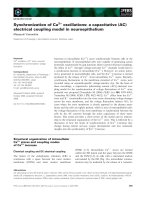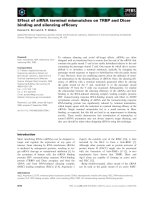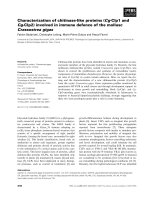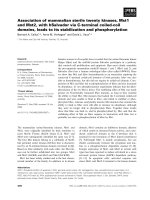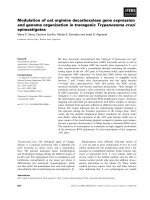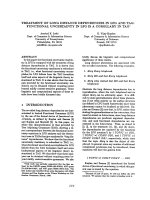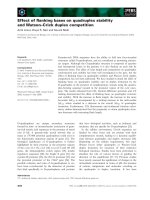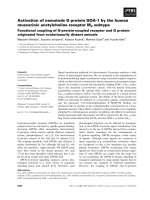Báo cáo khoa học: Complexes of Thermoactinomyces vulgaris R-47 a-amylase 1 and pullulan model oligossacharides provide new insight into the mechanism for recognizing substrates with a-(1,6) glycosidic linkages docx
Bạn đang xem bản rút gọn của tài liệu. Xem và tải ngay bản đầy đủ của tài liệu tại đây (615.32 KB, 9 trang )
Complexes of Thermoactinomyces vulgaris R-47 a-amylase 1
and pullulan model oligossacharides provide new insight
into the mechanism for recognizing substrates with a-(1,6)
glycosidic linkages
Akemi Abe
1
, Hiromi Yoshida
1,2
, Takashi Tonozuka
3
, Yoshiyuki Sakano
3
and Shigehiro Kamitori
1,2
1 Graduate School of Medicine, Kagawa University, Japan
2 Molecular Structure Research Group, Information Technology Center, Kagawa University, Japan
3 Department of Applied Biological Science, Tokyo University of Agriculture & Technology, Japan
a-Amylase (a-1,4-d-glucan-4-glucanohydrolase, EC
3.2.1.1) catalyses the hydrolysis of a-(1,4) glycosidic
linkages in starch to release the a-anomer, and is a mem-
ber of glycoside hydrolase family 13 (GH13) of the
sequence-based classification of glycoside hydrolases [1]
(CAZY website, />Thermoactinomyces vulgaris R-47 produces an extra-
cellular a-amylase 1 (TVAI, 637 amino acid residues)
[2]. TVAI efficiently hydrolyses not only starch but
also pullulan (Fig. 1). Pullulan is a linear polysaccha-
ride with sequence repeats of a-(1,4), a-(1,4) and
a-(1,6) glycosidic linkages, and is little hydrolysed by
general a-amylases. TVAI mainly hydrolyses a-(1,4)
glycosidic linkages of pullulan, but can also hydrolyse
a-(1,6) glycosidic linkages: the ratio of activity of
hydrolysis for a-(1,4) and a-(1,6) glycosidic linkages is
27 : 1 [3]. We reported the crystal structures of TVAI
[4], a complex of TVAI with the inhibitor acarbose
Keywords
X-ray structure; a-amylase; pullulan;
enzymatic glucoside hydrolysis;
Thermoactinomyces vulgaris
Correspondence
S. Kamitori, Molecular Structure Research
Group, Information Technology Center,
Kagawa University, 1750-1 Ikenobe,
Miki-cho, Kita-gun, kagawa 761-0793, Japan
Tel ⁄ Fax: +81 87 891 2421
E-mail:
(Received 16 August 2005, revised 4
October 2005, accepted 11 October 2005)
doi:10.1111/j.1742-4658.2005.05013.x
Thermoactinomyces vulgaris R-47 a-amylase 1 (TVAI) has unique hydrolyz-
ing activities for pullulan with sequence repeats of a-(1,4), a-(1,4), and
a-(1,6) glycosidic linkages, as well as for starch. TVAI mainly hydrolyzes
a-(1,4) glycosidic linkages to produce a panose, but it also hydrolyzes
a-(1,6) glycosidic linkages with a lesser efficiency. X-ray structures of
three complexes comprising an inactive mutant TVAI (D356N or
D356N ⁄ E396Q) and a pullulan model oligosaccharide (P2; [Glc-a-(1,6)-
Glc-a-(1,4)-Glc-a-(1,4)]
2
or P5; [Glc-a-(1,6)-Glc-a-(1,4)-Glc-a-(1,4)]
5
) were
determined. The complex D356N ⁄ P2 is a mimic of the enzyme ⁄ product
complex in the main catalytic reaction of TVAI, and a structural compar-
ison with Aspergillus oryzae a-amylase showed that the (–) subsites of
TVAI are responsible for recognizing both starch and pullulan.
D356N ⁄ E396Q ⁄ P2 and D356N ⁄ E396Q ⁄ P5 provided models of the
enzyme ⁄ substrate complex recognizing the a-(1,6) glycosidic linkage at the
hydrolyzing site. They showed that only subsites )1 and )2 at the non-
reducing end of TVAI are effective in the hydrolysis of a-(1,6) glycosidic
linkages, leading to weak interactions between substrates and the enzyme.
Domain N of TVAI is a starch-binding domain acting as an anchor in the
catalytic reaction of the enzyme. In this study, additional substrates were
also found to bind to domain N, suggesting that domain N also functions
as a pullulan-binding domain.
Abbreviations
ACA, acarbose; BNPL, neopullulanase from Bacillus stearothermophilus; D356N, mutant TVAI (Asp356 fi Asn); D356N ⁄ E396Q, mutant TVAI
(Asp356 fi Asn and Glu396 fi Gln); G13, maltotridecaose; G6, maltohexaose; P2, [Glc-a-(1,6)-Glc-a-(1,4)-Glc-a-(1,4)]
2
; P5, [Glc-a-(1,6)-Glc-a-
(1,4)-Glc-a-(1,4)]
5
; TAA, a-amylase from Apergillus oryzae; TVAI, Thermoactinomyces vulgaris R-47 a-amylase 1.
FEBS Journal 272 (2005) 6145–6153 ª 2005 The Authors Journal Compilation ª 2005 FEBS 6145
(TVAI ⁄ ACA), and complexes of an inactive mutant
TVAI (Asp356 to Asn and Glu396 to Gln, D356N ⁄
E396Q) with malto-hexaose (G6) and malto-tridecaose
(G13) [5]. These studies revealed the recognition mech-
anism of starch, but that of pullulan containing a-(1,6)
glucosidic linkages is still unclear.
TVAI has an N-terminal distorted b-barrel domain
(domain N), in addition to three conserved domains
(domains A, B and C) in a-amylase (Fig. 2) [4].
Among members of GH13, several enzymes having an
additional N-terminal domain have been reported.
They are Thermus sp. maltogenic amylase [6], Flavo-
bacterium cyclodextrinase [7], Bacillus stearothermophi-
lus neopullulanase (BNPL) [8], and Thermoactinomyces
vulgaris R-47 a-amylase 2 [9], all of which have a
homo-dimeric or -tetrameric structure with domain N
acting as a connector. By contrast, TVAI adopts a
monomeric structure with domain N, a starch-binding
domain, acting as an anchor in the catalytic reaction
of the enzyme, leading to efficient hydrolysing activity
for raw starch [5]. Neopullulanase (EC 3.2.1.135)
hydrolyses pullulan at the same sites as TVAI [10].
Although the crystal structure of BNPL in com-
plexes with panose [Glc-a-(1,6)-Glc-a-(1,4)-Glc], iso-
panose [Glc-a-(1,4)-Glc-a-(1,6)-Glc], and maltotetraose
[Glc-a-(1,4)-Glc-a-(1,4)-Glc-a-(1,4)-Glc] has been deter-
mined [8], the oligosaccharides used in these analyses
are too small to elucidate the pullulan-recognition
mechanism.
To elucidate the mechanism by which TVAI recogni-
zes pullulan and the role of domain N in the pullulan-
hydrolysing reaction, we report here the structures of
three complexes comprising inactive mutant TVAIs
(Asp356 to Asn, D356N; Asp356 to Asn and Glu396
to Gln, D356N ⁄ E396Q) and pullulan model oligosac-
charides (P2; [Glc-a (1,6)-Glc-a-(1,4)-Glc-a-(1,4)]
2
and
P5; [Glc-a-(1,6)-Glc-a-(1,4)-Glc-a-(1,4)]
5
); D356N ⁄ P2,
D356N ⁄ E396Q ⁄ P2, and D356N ⁄ E396Q ⁄ P5.
Results and Discussion
Quality of the structures
The structures have been refined to R-factors of 0.154
(D356N ⁄ P2), 0.156 (D356N ⁄ E396Q ⁄ P2), and 0.150
(D356N ⁄ E396Q ⁄ P5), with good chemical geometries,
as indicated in Table 1. Luzzati plots [11] give esti-
mates of errors in the atomic positions of around
0.17 A
˚
(D356N ⁄ P2), 0.18 A
˚
(D356N ⁄ E396Q ⁄ P2), and
0.21 A
˚
(D356N ⁄ E396Q ⁄ P5). The final (2F
o
–F
c
) elec-
tron density maps of the crystal structures (1 r con-
toured) show that all protein atoms, solvent molecules,
and Ca
2+
are well fitted, except for the loop region
from Ser282 to Gln284 in D356N ⁄ E396Q ⁄ P2 (Fig. 2).
In Ramachandran plots [12], 86.9% (D356N⁄ P2),
84.2% (D356N⁄ E396Q ⁄ P2), and 83.8% (D356N ⁄
E396Q ⁄ P5) of amino acid residues are shown to be in
the most favoured regions, and no amino acid residue
is present in disallowed regions as determined with the
program procheck [13].
Fig. 2. Overall structure of TVAI (D356N ⁄ E396Q ⁄ P5). Domains N,
A, B, and C are drawn in blue, green, yellow, and pink, respect-
ively. The binding substrates and Ca
2+
are shown by a wire-style
model and as orange spheres. The catalytic site, site-N, site-NA,
site-A, and site-C, are labelled. The loop region from Ser282 to
Gln284 in D356N ⁄ E396Q ⁄ P2 with poor electron density is shown
in red.
Fig. 1. Chemical structures of the repeat units of pullulan, P2 and
P5. A solid arrow indicates the main hydrolysing site, and a dashed
arrow indicates the minor site of pullulan hydrolysed by TVAI.
Structure of a-amylase with pullulan model ligand A. Abe et al.
6146 FEBS Journal 272 (2005) 6145–6153 ª 2005 The Authors Journal Compilation ª 2005 FEBS
Overall structures
TVAI is comprised of four domains; domain N (resi-
dues 1–123) with a distorted b-barrel structure, domain
A (124–265 and 321–553) with a (b ⁄ a)
8
barrel struc-
ture, domain B (266–320) protruding from domain A,
and domain C (554–637) with a b-sandwich structure,
as shown in Fig. 2. The r.m.s. deviations for Ca atoms
compared to wild-type TVAI without ligands (un-
liganded TVAI) are 0.5 A
˚
(D356N ⁄ P2), 0.8 A
˚
(D356N ⁄ E396Q ⁄ P2), and 0.5 A
˚
(D356N ⁄ E396Q ⁄ P5),
suggesting that all these structures are very similar.
The crystal form of D356N⁄ E396Q ⁄ P2 is different
from that of any other TVAI structure, leading to
the slightly large deviation of 0.8 A
˚
(see Experimental
procedures). Matthew’s coefficient for the crystal struc-
ture of unliganded TVAI and D356N ⁄ E396Q ⁄ P2 is
2.3 A
˚
3
ÆDa
)1
and 1.7 A
˚
3
ÆDa
)1
, respectively, showing
that D356N ⁄ E396Q ⁄ P2 is densely packed with many
contacts between symmetric molecules. Therefore, to
avoid steric hindrance in the area of intermolecular
contact, some of the molecular-surface loops of
D356N ⁄ E396Q ⁄ P2 adopt slightly different conforma-
tions from those of other structures.
The simulated annealing omit (F
o
–F
c
) maps of the
substrate at the catalytic site are shown in Fig. 3. As
reported [5], TVAI has four substrate-binding sites in
addition to the catalytic site. They are located in the
N-terminal region in domain N (site-N), at the inter-
face between domains N and A (site-NA), in the centre
Table 1. Refinement statistics.
Data set D356N ⁄ P2 D356N ⁄ E396Q ⁄ P2 D356N ⁄ E396Q ⁄ P5
Resolution range (A
˚
) 46–2.08 33–2.6 35–2.6
Reflections (n) 38 345 28 120 19,275
Completeness (%) 99.7 (99.2)
a
99.7 (99.5)
a
96.7 (84.1)
a
R
crystal
0.154 (0.155)
a
0.156 (0.194)
a
0.150 (0.183)
a
R
free
0.187 (0.211)
a
0.200 (0.254)
a
0.190 (0.264)
a
r.m.s.d. bond lengths (A
˚
) 0.005 0.006 0.006
r.m.s.d. bond angles (°) 1.3 1.3 1.3
Atoms (n)
Protein 5038 5038 5038
Heterogen atoms 125 78 225
Solvent molecules 452 383 474
Average B-factors
Protein (A
˚
2
) 11.9 16.4 13.9
Substrate molecules (A
˚
2
) 42.3 37.7 54.5
Solvent molecules (A
˚
2
) 21.5 25.6 19.4
a
The values for the highest resolution shell are given in parentheses (2.21–2.08 A
˚
for D356N/P2, 2.23–2.10 A
˚
for D356N/E396Q/P2, and
2.76–2.60 A
˚
for D356N/E396Q/P5).
Fig. 3. Simulated annealing omit (F
o
–F
c
) maps of the substrate at the catalytic site in (A) D356N ⁄ P2 (B) D356N ⁄ E396Q ⁄ P2, and (C)
D356N ⁄ E396Q ⁄ P5. The contour level of these maps is 3.0 r. Three catalytic residues, Asn356, Gln396 (Glu396 in D356N ⁄ P2), and Asp472,
are shown in yellow.
A. Abe et al. Structure of a-amylase with pullulan model ligand
FEBS Journal 272 (2005) 6145–6153 ª 2005 The Authors Journal Compilation ª 2005 FEBS 6147
of domain A (site-A), and in domain C (site-C)
(Fig. 2). In this study, the substrates were found bound
to these sites in the electron density map. The number
of glucose units to bind to the catalytic site and site-N
and average B-factor of each glucose unit are summar-
ized in Fig. 4. Because of the dense molecular packing,
in D356N ⁄ E396Q ⁄ P2, the substrate binds to the cata-
lytic site only.
Catalytic site of D356N ⁄ P2 recognizing a-(1,4)
glycosidic linkages at the hydrolysing site
Figure 5 shows the structure of the catalytic site of
D356N ⁄ P2. In D356N ⁄ P2, the five glucose units bind-
ing to the catalytic site are defined as Glc–5 to Glc–1
from the nonreducing to reducing end. The number
indicates the subsite, and the site of hydrolysis is
between subsites )1 and +1. Although P2 has six glu-
cose units, only five could be observed in the electron
density map. As there is no glucose unit at (+) sub-
sites, D356N ⁄ P2 is a mimic of the enzyme ⁄ product
complex. Because a-(1,4) and a-(1,6) glycosidic link-
ages are found between Glc–1 and Glc–2, and between
Glc–2 and Glc–3, respectively, the mode of binding
found in this structure is for the main catalytic reac-
tion of TVAI with pullulan, which hydrolyses the
a-(1,4) glycosidic linkage to produce panose. The cata-
lytic site of D356N ⁄ E396Q ⁄ G6 is superimposed to that
of D356N ⁄ P2 in Fig. 5. D356N ⁄ E396Q ⁄ G6 is also a
mimic of the enzyme ⁄ product complex with glucose
units at subsites )1to)5 [5].
At subsites )1 and )2, the substrate conformations
and interactions with the enzyme are very similar
between D356N ⁄ P2 and D356N ⁄ E396Q ⁄ G6. In both
structures, the O2 and O3 atoms of Glc–2 and Glc–1
form hydrogen bonds with Arg520 and Asp472,
respectively, to fix the orientation and position of
Glc–2 and Glc–1. However, the water molecule (HOH7)
forming tight hydrogen bonds with Arg354 affects the
position of Glc–1 in D356N ⁄ P2. In D356N ⁄
E396Q ⁄ G6, the O2 atom of Glc–1 occupies the posi-
tion of HOH7 and hydrogen bonds with His471 and
Arg354, allowing Glc–1 of G6 to bind to subsite )1
more deeply than that of P2. This may be caused by
Fig. 5. Stereoview of the catalytic site of D356N ⁄ P2. The binding of P2 is shown in green, and the binding of G6 and Phe313 in
D356N ⁄ E396Q ⁄ G6 in purple. Subsite numbers are given. The O6 atom of a-(1,6) glycosidic linkage is shown by a relatively large ball. The
water molecule HOH7 in D356N ⁄ P2 is shown as a red sphere. The selected hydrogen bond interactions are shown with dotted lines.
Fig. 4. Schematic diagram of the substrates bindings to the catalytic site and site-N. Glucose units and a-(1,6) glycosidic linkage are shown
by circles and red lines, respectively. The average B-factors (A
˚
2
) of glucose units are also shown. The occupancies of glucose units were set
to 1.0 through the refinement.
Structure of a-amylase with pullulan model ligand A. Abe et al.
6148 FEBS Journal 272 (2005) 6145–6153 ª 2005 The Authors Journal Compilation ª 2005 FEBS
the differently replaced amino acid residues. Asn356
in D356N ⁄ E396Q ⁄ G6 makes a hydrogen bond with
Arg354, while Asn356 in D356N ⁄ P2 makes a hydrogen
bond not with Arg354 but with Glu396, allowing
Arg354 to make two hydrogen bonds with HOH7. In
D356N ⁄ E396Q ⁄ G6, due to the minor displacement of
Trp398 caused by the replacement of Glu396, the sub-
strate only binds to (–) subsites. In D356N ⁄ P2, HOH7
may avoid a substrate to bind to (+) subsites.
Although the interactions between the enzyme and
substrates at subsites )3to)5 differ completely
between P2 and G6, due to the a-(1,6) glucosidic link-
age in P2, the catalytic site structure of TVAI fits well
into both substrates. In D356N ⁄ P2, many hydrogen
bonds are found at subsites )3to)5; the O3, O2, and
O5 atoms of Glc–3 form hydrogen bonds with Ser182,
His221, and Ser315, respectively, and the O2 atom of
Glc–4 forms hydrogen bonds with Asp180 and Ser182,
while in D356N ⁄ E396Q ⁄ G6, only one hydrogen bond,
between the O3 atom of Glc–3 and Asp516, is found
at subsites )3to)5, suggesting that TVAI has (–) sub-
sites that are more suitable for pullulan than for
starch.
Phe313 changes the conformation of its side chain
depending on the structure of the substrate to form
favorable interactions with the substrate. In the bind-
ing of G6, Phe313 mainly interacts with the six mem-
bered ring of Glc–3, while in the binding of P2, it
makes contact with the C6 atoms of Glc–2 and Glc–3.
Phe313 is unique to TVAI, and there is no correspond-
ing amino acid residue in other a-amylases. Thus,
Phe313 is a key residue for the recognition of both
starch and pullulan as a substrate.
Structural comparison of the catalytic site
between TVAI and other a-amylases
Since pullulan with regular repeats of a-(1,6), a-(1,4),
and a-(1,4) glycosidic linkages is expected to have a
different three-dimensional structure from starch, few
a-amylases have pullulan-hydrolysing ability [14]. To
elucidate the reason why TVAI hydrolyses pullulan
efficiently, the catalytic structure of D356N⁄ P2 with
the substrate was compared with that of Aspergillus
oryzae a-amylase (TAA), an enzyme without activity
to hydrolyse pullulan [15]. P2 fits well into the catalytic
cleft of TVAI, whereas steric hindrance occurs in the
cleft of TAA. This is because (–) subsites differ com-
pletely in shape. In TVAI, there are two hydrophilic
residues at (–) subsites, Asp180 and Ser182, which
form hydrogen bonds with Glc–3 and Glc–4 that help
to stabilize pullulan. On the other hand, in TAA, there
are three hydrophobic residues at (–) subsite, Tyr75,
Trp83, and Val171, which make a hydrophobic wall
that prevents the binding of pullulan to the catalytic
site. This hydrophobic wall is suitable for the binding
of amylose with a helical structure, where the O2
atoms form hydrogen bonds with the O3 atoms of
adjacent glucose unit [16]. Thus, the shape of the cata-
lytic cleft at (–) subsites of TVAI is responsible for the
recognition of both starch and pullulan.
Catalytic site structures of D356N ⁄ E396Q ⁄ P2 and
D356N ⁄ E396Q ⁄ P5 recognizing a-(1,6) glycosidic
linkages at the hydrolysing site
In D356N ⁄ E396Q ⁄ P2, six glucose units bind to the
catalytic site, designated Glc–4 to Glc+2 from the
nonreducing to reducing end, and in D356N ⁄
E396Q ⁄ P5, 10 glucose units bind to the catalytic site,
Glc–8 to Glc+2 (Fig. 6). In both D356N ⁄ E396Q ⁄ P2
and D356N ⁄ E396Q ⁄ P5, the glycosidic linkage between
Glc–1 and Glc+1 is an a-(1,6) glycosidic linkage.
TVAI mainly hydrolyses pullulan at the a-(1,4) glycosi-
dic linkage, but it also has the ability to hydrolyse the
a-(1,6) glycosidic linkage, as previously mentioned.
Therefore, either structure could be a model of the
enzyme ⁄ substrate complex recognizing an a-(1,6) gly-
cosidic linkage at the hydrolysing site, and this sub-
strate binding mode is for the minor catalytic reaction
of TVAI. It is thought that these structures could be
obtained by the replacement of amino acid residues.
Glu396 of wild-type TVAI forms a strong hydrogen
bond with Trp398 (NE1) to fix its position and orien-
tation, but this hydrogen bond does not occur in
D356N ⁄ E396Q, resulting in the minor displacement of
Trp398. In D356N ⁄ E396Q ⁄ G6, the displacement of
Trp398 causes steric hindrance between the indole ring
of Trp398 and the substrate, and so the substrate
binds only to (–) subsites. The bound inhibitor acar-
bose (ACA) and Trp398 in TVAI ⁄ ACA are also super-
imposed in Fig. 6, where ACA binds at subsites )3to
+2. The glucose unit at subsite +2 of ACA makes
nice stacking interactions with Trp398 (pink), but
the ACA and the displaced Trp398 (yellow) in
D356N ⁄ E396Q make unusual short contacts at subsite
+2. This displacement of Trp398 seems not to affect
the binding of substrates with a-(1,6) glycosidic link-
ages at the hydrolysing site. P2 and P5 can fit into the
catalytic site by changing three torsion angles of
a-(1,6) glycosidic linkages at the hydrolysing site, and
the displaced Trp398 in D356N ⁄ E396Q ⁄ P2 or
D356N ⁄ E396Q ⁄ P5 makes a hydrogen bond with the
O4 atom of Glc+1 and favourable contacts with
Glc+2, giving a plausible enzyme ⁄ substrate structure.
Although the displacement of Trp398 is tiny (about
A. Abe et al. Structure of a-amylase with pullulan model ligand
FEBS Journal 272 (2005) 6145–6153 ª 2005 The Authors Journal Compilation ª 2005 FEBS 6149
1A
˚
), this structural change in wild-type TVAI requires
the energy to break the hydrogen bond between
Trp398 and Glu396. This may be why TVAI has weak
hydrolysing activity for a-(1,6) glycosidic linkages com-
pared to a-(1,4) glycosidic linkages.
In both, D356N ⁄ E396Q ⁄ P2 and D356N ⁄ E396Q ⁄ P5,
Glc–1 and Glc–2 at (–) subsites have similar conforma-
tions and interactions to those found in D356N ⁄ P2 and
other ligand ⁄ complex structures of TVAI. However,
the location of glucose units after Glc–3 varies between
P2 and P5. In D356N ⁄ E396Q ⁄ P2, the O2 and O3
atoms of Glc–4 form hydrogen bonds with Asp180,
while in D356N ⁄ E396Q ⁄ P5, the Glc–6 forms three
hydrogen bonds with Ala515 (O3), Asp516 (O2), and
Tyr174 (O3). This suggests that only subsites )1 and
)2 at the nonreducing end of TVAI are involved in the
hydrolysis of a-(1,6) glycosidic linkages as a effective
subsite, leading to weak interaction between the sub-
strate and the enzyme which allows substrates of var-
ious conformations to bind at subsites after Glc–3.
Maybe this is another reason why TVAI has weak
hydrolysing activity for a-(1,6) glycosidic linkages.
Asp356, Glu396, and Asp472 are key residues for
the hydrolysing activity. As the first step in the pro-
posed mechanism behind the hydrolysis of a-(1,4) gly-
cosidic linkage, the OE atom of Glu396 protonates the
O4 atom (glucoside oxygen) at the hydrolysing site
[17,18], and subsequently the OD atom of Asp356
attacks the C1 atom of the glucose at subsite )1 [19].
Asp472 has been suggested to be involved in fixing the
substrate and in stabilizing the transition state [20]. In
D356N ⁄ E396Q ⁄ P2 and D356N ⁄ E396Q ⁄ P5, the NE2
atom of Gln396 (changed from Glu) forms a hydrogen
bond with the O6 atom at the hydrolysing site, and
Asp472 forms hydrogen bonds with the O2 and O3
atoms of Glc1. The OD1 atom of Asn356 (changed
from Asp) is positioned to attack the C1 atom of
Glc–1 [19]. These structures suggest that the mechan-
ism by which TVAI hydrolyses a-(1,6) glycosidic link-
ages is almost the same as that proposed for the
hydrolysis of a-(1,4) glycosidic linkages.
Substrate-binding sites on the molecular surface
Besides the catalytic site, substrates bind to sites-N,
NA, A, and C in D356N ⁄ E396Q ⁄ P5 and to site-N
in D356N ⁄ P2. Based on the X-ray structure of
D356N ⁄ E396Q ⁄ G13, we proposed that site-N helps
the enzyme to approach starch by recognizing the heli-
cal structure of amylose like a starch granule-binding
site, and that site-NA recognizes specifically the isola-
ted helical structure, or to unravel the rigid helical
structure of amylose, in order to help the catalytic site
to catch the structure of starch [5].
On site-N, three glucose units are found in
D356N ⁄ P2 and five in D356N ⁄ E396Q ⁄ P5, as shown in
Fig. 6. Stereoview of the catalytic site of D356N ⁄ E396Q ⁄ P5. The binding of P2 and P5 is shown in orange and blue, respectively. The bind-
ing of ACA and Trp398 in TVAI ⁄ ACA is shown in grey. Subsite numbers are given. The O6 atoms of a -(1,6) glycosidic linkages are shown by
relatively large balls. The selected hydrogen bond interactions are shown with dotted lines.
Structure of a-amylase with pullulan model ligand A. Abe et al.
6150 FEBS Journal 272 (2005) 6145–6153 ª 2005 The Authors Journal Compilation ª 2005 FEBS
Fig. 7. Since the substrates in site-N do not make any
contacts with the symmetric protein molecules, but
with only water molecules, the conformations of the
substrates are thought to be free from the molecular
packing effects. As shown in Fig. 7, glucose units from
the nonreducing to reducing end are designated P2_N1
to N3 for D356N ⁄ P2 and P5_N1 to N5 for
D356N ⁄ E396Q ⁄ P5, and the binding of G13 to
D356N ⁄ E396 is also superimposed. P2_N1 to N3 are
linked by two a-(1,4) glycosidic linkages, and P5_N1
to N5 are linked by a-(1,4), a-(1,4), a-(1,6), and a-(1,4)
glycosidic linkages. Although the conformation of
P2 is almost equivalent to that of G13, the mode of
binding of P5 is unique. When binding with a large
substrate, P5 coils itself around Trp65 by bending
at the a-(1,6) glycosidic linkage, resulting in
many hydrogen bonds between P5 and the enzyme;
namely P5_N1(O4)–Asp66(O), P5_N4(O2)–Asp75(OD2),
P5_N4(O2)–Asp75(OD1), P5_N5(O2)–Asn68(OD1),
P5_N5(O3)–Asn68(ND2), and P5_N5(O3)–Asp75(OD1).
This suggests that domain N acts as a pullulan-
binding domain as well as a starch-binding domain, and
Trp65 in particular is a responsible for recognizing
pullulan.
The affinity of pullulan for site-NA is thought to be
less than that for site-N and ⁄ or the affinity of starch
for site-NA, because only two glucose units linked
by a a-(1,4) glycosidic linkage are found in
D356N ⁄ E396Q ⁄ P5. Site-NA forms a deep groove to
recognize specifically the helical structure of amylose,
but P2 and P5 are expected not to form a helical shape
like amylose [14,15], leading to poor affinity of pullu-
lan for site-NA.
In site-A and site-C, one glucose unit with high tem-
perature factor is found. The hydrogen bond schemes
at these sites are also obscure, as in D356N ⁄
E396Q ⁄ G13. Thus, the roles of these substrate binding
sites are still unclear.
Our results show the substrate recognition mechan-
ism of TVAI behind the hydrolysis of both starch and
pullulan, the complete substrate binding mode in the
hydrolysis of a-(1,6) glycosidic linkages which is the
minor catalytic reaction of TVAI, and the role of
domain N as a pullulan-binding domain. In future
study, we will elucidate the complete pullulan binding
mode of TVAI in the major catalytic reaction and how
domain N as a substrate-binding domain contributes
the catalytic reaction of TVAI.
Experimental procedures
Site-directed mutagenesis
So far, we have prepared three inactive mutant TVAIs,
D356N, E396Q and D356N ⁄ E396Q, from recombinant
Escherichia coli JM109 cells, because crystallization pro-
cedure in various combinations of a mutant TVAI and a
substrate was needed to obtain successful crystals of
TVAI ⁄ substrate complexes. The gene constructions of
E396Q and D356N ⁄ E396Q have already been reported [5].
That of D356N was carried out using the plasmid pTV93
with the QuickChange site-directed mutagenesis kit (Strata-
gene). The oligonucleotide used to produce D356N was
5¢-GTTGGCGGCTCAATGCTGCGCAATATGTTGA-3¢.
Crystallization, X-ray data collection, and
structure determination
The substrates of P2 and P5 were synthesized and purified
as reported [21]. D356N and D356N ⁄ E396Q were purified
in the same way as wild-type TVAI [22], and confirmed to
have no hydrolysing activities to pullulan by the dinitrosali-
cylic acid method. D356N was crystallized in the same way
as wild-type TVAI, using a reservoir solution containing
1–4% (w ⁄ v) PEG20000 and 50 mm Mes (pH 6.5). While
D356N ⁄ E396Q was crystallized under two sets of condi-
tions: the same conditions as for the wild-type or using a
reservoir solution composed of 1–3% (w ⁄ v) PEG10000 and
12.5 mm KH
2
PO
4
, leading to different crystal forms (Form
1 and Form 2), because Form 1 could not give a crystal of
Fig. 7. The substrate-binding at site-N. The binding of P5, P2 and
G13 is shown in blue, green, and gray, respectively. The O6 atom
of a-(1,6) glycosidic linkage is shown by a relatively large ball. The
selected hydrogen bond interactions are shown with dotted lines.
A. Abe et al. Structure of a-amylase with pullulan model ligand
FEBS Journal 272 (2005) 6145–6153 ª 2005 The Authors Journal Compilation ª 2005 FEBS 6151
D356N ⁄ E396Q ⁄ P2. To introduce the substrate, each crys-
tal, D356N, D356N ⁄ E396Q (Form 1), and D356N ⁄ E396Q
(Form 2), was soaked in cryo-protectant solution (15%
(w ⁄ v) PEG20000, 15% (v ⁄ v) 2 methyl 2,4 pentanediol
(MPD), and 50 mm Mes buffer, pH 6.5) containing 5 mm
of P2 or P5 for 8 h. Many sets of data were collected using
synchrotron radiation on BL18B and NW12 in the Photon
Factory, and on BL44XU in SPring-8. Because the X-ray
diffraction data for some crystals were too poor to be pro-
cessed, only the data for D356N ⁄ P2, D356N ⁄ E396Q ⁄ P2
(Form 2), and D356N ⁄ E396Q ⁄ P5 (Form 1) could be pro-
cessed and scaled using the programs hkl2000 [23], mosflm
[24] and ccp4 [25], as listed in Table 2. The structures of
D356N ⁄ P2, D356N ⁄ E396Q ⁄ P2, and D356N ⁄ E396Q ⁄ P5
were determined by a molecular replacement method, using
the structure of wild-type TVAI (PDB code 1JI1) as a
model. All calculations regarding molecular replacement
and structure refinement were performed with the program
CNS [26]. Models were corrected in (2F
o
–F
c
) electron den-
sity maps using the program Xfit [27] in the xtalview sys-
tem [28], and structures without solvent molecules were
refined using maximum resolution data. At this stage, sac-
charide moieties were added to the structure. Solvent mole-
cules were gradually added if the electron density level was
at least 3.0 r in the (F
o
–F
c
) electron density map and the
hydrogen-bonding geometry was correct. The solvent mole-
cules with a temperature factor above 50 A
˚
2
were removed.
To avoid overfitting of the diffraction data, a free R-factor
with 10% of the test set excluded from refinement was
monitored [29]. After several cycles of positional and
temperature factor refinements, models with an R-factor of
0.154 (D356N ⁄ P2), 0.156 (D356N ⁄ E396Q ⁄ P2) and 0.150
(D356N ⁄ E396Q ⁄ P5) were obtained. Figures 2, 5, 6 and 7
were made with the programs molscript [30] and Ras-
ter3d [31], and Fig. 3 with the program pymol [32].
Protein Data Bank accession numbers
The atomic coordinates and structural factors of
D356N ⁄ P2 (code 2D0F), D356N ⁄ E396Q ⁄ P2 (code 2D0H),
and D356N ⁄ E396Q ⁄ P5 (code 2D0G) have been deposited
in the Protein Data Bank, Research Collaboratory for
Structural Bioinformatics, Rutgers University, New Bruns-
wick, NJ, USA.
Acknowledgements
This study was supported by Grants-in-Aid for Scienti-
fic Research (16370048) from the Ministry of Edu-
cation, Culture, Sports, Science and Technology of
Japan. The author (A. A) is supported by Research
Fellowship for Young Scientists (17–6519) from Japan
Society of the Promotion of Science. This research was
performed with the approval of the Photon Factory
Advisory Committee, and the National Laboratory for
High Energy Physics, Japan (Proposal 2003G305), and
SPring-8, Institute for Protein Research (Proposal
C05A44XU-7104-N for BL44XU).
References
1 Henrissat B (1991) A classification of glycosyl hydrases
based on amino acid sequence similarities. Biochem J
280, 309–316.
2 Tonozuka T, Mogi S, Shimura Y, Ibuka A, Sakai H,
Matsuzawa H, Sakano Y & Ohta T (1995) Comparison
of primary structures and substrate specificities of two
pullulan-hydrolyzing a-amylases, TVA I and TVA II,
from Thermoactinomyces vulgaris R-47. Biochem Bio-
phys Acta 1252, 35–42.
3 Ibuka A, Tonozuka T, Matsuzawa H & Sakai H (1998)
Conversion of neopullulanase-a-amylase from Thermo-
actinomyces vulgaris R-47 into an amylopullulanase-type
enzyme. J Biochem 123, 275–282.
4 Kamitori S, Abe A, Ohtaki A, Kaji A, Tonozuka T &
Sakano Y (2002) Crystal structures of Thermoactino-
myces vulgaris R-47 a-amylase 1 (TVA I) at 1.6 A
˚
reso-
lution and a-amylase 2 (TVA II) at 2.3 A
˚
resolution.
J Mol Biol 318, 443–453.
5 Abe A, Tonozuka T, Sakano Y & Kamitori S (2004)
Complex structures of Thermoactinomyces vulgaris R-47
a-amylase 1 with malto-oligosaccharides demonstrate
the role of domain N acting as a starch-binding domain.
J Mol Biol 335, 811–822.
Table 2. Data collection statistics.
Data set D356N ⁄ P2
D356N ⁄
E396Q ⁄ P2
D356N ⁄
E396Q ⁄ P5
Temperature (K) 100 100 100
Resolution (A
˚
) 2.08 2.1 2.6
Measured
reflections (n)
137 329 98 124 59,023
Unique reflections 38 446 28 140 19,275
Completeness (%) 99.8 99.9 96.8
R
merge
a
0.063 (0.149)
b
0.064 (0.195)
b
0.078 (0.122)
b
I
o
⁄ r(I
o
) 17.4 (12.9)
b
9.7 (3.6)
b
7.4 (5.4)
b
Space group C2 P2
1
C2
Cell dimensions
a (A
˚
) ¼ 121.5 47.5 120.9
b (A
˚
) ¼ 50.4 92.3 50.7
c (A
˚
) ¼ 107.8 55.9 108.0
b (°) ¼ 104.3 91.4 103.4
Molecules in
asymmetric
unit (n)
111
a
R
merge
¼ SS |I
i
–<I>|⁄S <I>.
b
The values for the highest
resolution shell are given in parentheses (2.15–2.08 A
˚
for
D356N ⁄ P2, 2.20–2.10 A
˚
for D356N ⁄ E396Q ⁄ P2, and 2.73–2.60 A
˚
for D356N ⁄ E396Q ⁄ P5).
Structure of a-amylase with pullulan model ligand A. Abe et al.
6152 FEBS Journal 272 (2005) 6145–6153 ª 2005 The Authors Journal Compilation ª 2005 FEBS
6 Lee H-S, Kim M-S, Cho H-S, Kim J-I, Kim T-J, Choi
J-H, Park C, Lee H-S, Oh B-H & Park K-H (2002)
Cyclomaltodextrinase, neopullulanase, and maltogenic
amylase are nearly indistinguishable from each other.
J Biol Chem 277, 21891–21897.
7 Fritzsche HB, Schwede T & Schulz GE (2003) Covalent
and three-dimensional structure of the cyclodextrinase
from Flavobacterium sp, 92. Eur J Biochem 270, 2332–
2341.
8 Hondoh H, Kuriki T & Matsuura Y (2003) Three-
dimensional structure and substrate binding of Bacillus
stearothermophilus neopullulanase. J Mol Biol 326,
177–188.
9 Kamitori S, Kondo S, Okuyama K, Yokota T, Shimura
Y, Tonozuka T & Sakano Y (1999) Crystal structure of
Thermoactinomyces vulgaris R-47 a-amylase II (TVAII)
hydrolyzing cyclodextrins and pullulan at 2.6 A
˚
resolu-
tion. J Mol Biol 287, 907–921.
10 Takata H, Kuriki T, Okada S, Takesada Y, Iizuka M,
Minamiura N & Imanaka T (1992) Action of neopullu-
lanase. Neopullulanase catalyzes both hydrolysis and
transglycosylation at a-(1 fi 4)- and a-(1 fi 6)-gluco-
sidic linkages. J Biol Chem 267, 18447–18452.
11 Luzzati PV (1952) Traitement statistique des erreurs
dans la determination des structures cristallines. Acta
Crystallog 5, 802–810.
12 Ramachandran GN & Sasisekharan V (1968) Confor-
mation of polypeptides and proteins. Advan Protein
Chem 23, 283–437.
13 Laskowski RA, MacArthur MW, Moss DS & Thornton
JM (1992) PROCHECK: a program to check the stereo-
chemical quality of protein structures. J Appl Crystallog
26, 283–291.
14 Doman-Pytka M & Bardowski J (2004) Pullulan
degrading enzymes of bacterial origin. Crie Rev Micro-
biol 30, 107–121.
15 Brzozowski AM & Davies GJ (1997) Structure of the
Aspergillus oryzae a-amylase complexed with the inhib-
itor acarbose at 2.0 A
˚
resolution. Biochemistry 36,
10837–10845.
16 Nimz O, Gessler K, Uson I, Laettig S, Welfle H, Sheld-
rick GM & Saenger W (2003) X-ray structure of the
cyclomaltohexaicosaose triode inclusion complex pro-
vides a model for amylase-iodine at atomic resolution.
Carbohydr Res 338, 977–986.
17 Sinnot ML (1990) Catalytic mechanisms of enzymic
glycosyl transfer. Chem Rev 90, 1171–1202.
18 McCarter JD & Withers SG (1994) Mechanisms of
enzymatic glycoside hydrolysis. Curr Opin Struct Biol 4,
885–892.
19 Uitdehaag JCM, Mosi R, Kalk KH, van der Veen BA,
Dijkhuizen L, Withers SG & Dijkstra BW (1999) X-ray
structures along the reaction pathway of cyclodextrin
glycosyltransferase elucidate catalysis in a-amylase
family. Nature Struct Biol 6, 432–436.
20 Swift HJ, Brady L, Derewanda ZS, Dodson EJ, Dodson
GG, Turkenburg JP & Wilkinson AJ (1991) Structure
and molecular model refinement of Aspergillus oryzae
(TAKA) a-amylase: an application of the simulated-
annealing method. Acta Crystallog Sect B 47, 535–544.
21 Tonozuka T, Sakai H, Ohta T & Sakano Y (1994) A
convenient enzymatic synthesis of 4
2
-a-isomaltosyliso-
maltose using Thermoactinomyces vulgaris R-47 alpha-
amylase II (TVAII). Carbohydr Res 261, 157–162.
22 Kondo S, Kaji A, Yuguchi K, Tonozuka T, Sakano Y
& Kamitori S (2000) Crystallization and preliminary
X-ray analysis of Thermoactinomyces vulgaris R-47
a-amylase 1. Protein Pept Lett 7, 197–200.
23 Otwinowski Z & Minor W (1997) Processing of X-ray
diffraction data collected in oscillation mode. Methods
Enzymol 276, 307–326.
24 Leslie AGW (1991) Crystallographic Computing V
(Moras, D, Podjarny, A D & Thierry, J C, eds), pp.
27–38. Oxford University Press, Oxford.
25 Collaborative Computational Project number 4 (1994)
The CCP4 suite: programs for protein crystallography.
Acta Crystallog Sect D 50, 760–763.
26 Bru
¨
nger AT, Adams PD, Clore GM, Delano WL, Gros
P, Grosse-Kunstleve RW, Jiang J-S, Kuszewski J,
Nilges M, Pannu NS, Read RJ, Rice LM, Simonson T
& Warren GL (1998) Crystallography & NMR System:
a new software suite for macromolecular structure
determination. Acta Crystallog Sect D 54, 905–921.
27 McRee DE (1999) XtalView ⁄ Xfit: a versatile program
for manipulating atomic coordinate and electron den-
sity. J Struct Biol 125, 156–165.
28 McRee DE (1993) XtalView. Practical Protein Crystal-
lography (McRee, D E, ed.), Academic Press, New
York.
29 Bru
¨
nger AT (1992) Free R value: a novel statistical
quantity for assessing the accuracy of crystal structures.
Nature 355, 472–475.
30 Kraulis PJ (1991) MOLSCRIPT: a program to produce
both detailed and schematic plots of protein structures.
J Appl Crystallog 26, 283–291.
31 Merritt EA & Bacon DJ (1997) Raster3D: photorealistic
molecular graphics. Methods Enzymol 277, 505–524.
32 Delano WL (2002) The Pymol Molecular Graphic
System, DeLano Scientific, California.
A. Abe et al. Structure of a-amylase with pullulan model ligand
FEBS Journal 272 (2005) 6145–6153 ª 2005 The Authors Journal Compilation ª 2005 FEBS 6153
